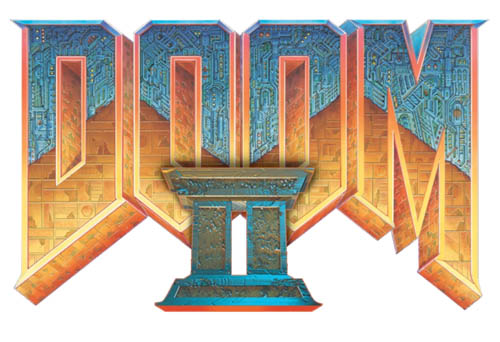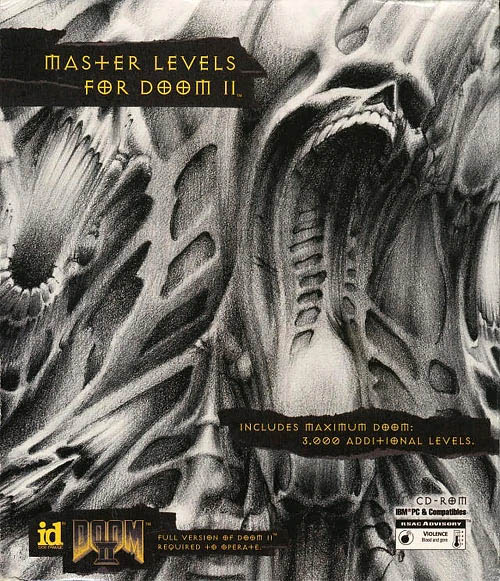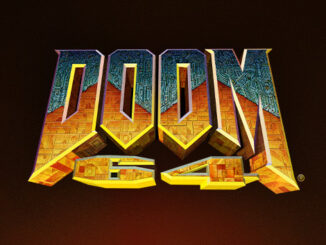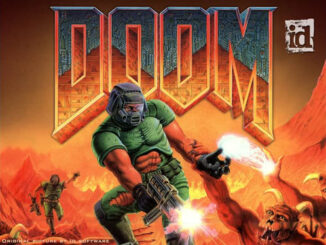
DOOM II: Hell on Earth Game Review
Published by id software – Developed by id Software – PC
The first sequel to the hallmark game that ushered in the era of the first-person-shooter. Hotly anticipated by eager crowds ready for more run-and-gun action, this game was, on release, the best selling video game of all time and to this day remains one of the highest selling titles in video game history. But now that the explosive dust has settled, let’s take a look back at what is, and what could have been.
Doom 2 is, in many ways, a game of two halves; there’s good and there‘s bad. But why?
Well, for context, the original game was released in December 1993, Doom 2 was released in September 1994 – that’s ten months development! Lightening fast by early 90s standards and full on warp-speed by today’s. And adding to what must have been an already truncated development cycle, there’s also the fact that, as raised in my previous Doom review, the guys at Id software released “The Ultimate Doom”, simultaneously with Doom 2 – a repackaging of the first three episodes that also added a fourth episode, “Thy Flesh Consumed”. So not only were they working on Doom 2, but also an additional nine levels for their original masterpiece.
So where does that leave us in the sequel? Well, let’s just say you can tell where efforts were made… and where they were not!
For instance, the game features no new graphical or technological improvements. Still no jumping or looking up or down. All the baddies, weapons and powerups from the first Doom reappear, copy/pasted. Gameplay additions include new monsters, one new weapon and one new powerup. In this regard Doom 2 functions more like an expansion pack than a full sequel.
The release edition of the game was version 1.666 (see what they did there!) and after release, patches were soon fired out, v1.7 then v1.8 and finally v1.9. They corrected a few issues, introduced some of their own, and then corrected those too. But these patches didn’t quite cover the entire quilt, there are still holes in the bedding to this day.
One of the most notable changes from the original is the dispensing of the episodic format for a more linear one. No longer do you have to load the next episode upon completing one, you just play the game straight through. Streamlined, yes, but gone are the end-of-level maps that show you which building you just blew up! Doom 2 has 32 levels, two of which are hidden, secret levels and as you progress through the game, you can still see the vestigial hints of the old episodic format, the first ten levels are military base themed, the following ten are set in a ruined city and the final transition places the player in hell (surprise surprise!).
And whilst we’re here, let’s tackle the “plot”, which is nicely summarised by the games subtitle. Demons, once on Mars, have now appeared on Earth, something something teleporters something something, GO GET ‘EM! (I sincerely hope Doom 2 is not a commentary on immigration!) The player once again takes the reigns of Doomguy for more carnage and mayhem.
Personally, I love the additions that Doom 2 brings to its game play. First, the double-barrelled shotgun. Where were you in the original!? Sure, it takes longer to reload than the pump action, but it’s punch is incredible, it shows up on the Richter scale and fells larger demons like they were fodder. The perfect weapon to help you out in a pinch. This weapon is so much fun that it leads to an interesting issue. Often, when I play the original Doom, the game really misses some double-barrelled action. Perhaps an odd complaint to lay at the feet of the original game that I sometimes miss using a weapon that that game never featured but then it’s not a mutually exclusive issue, as with all franchises, these are nested issues, it can often be difficult to talk about one entry in any franchise without referencing another. And considering the lack of innovation in this game I’d forgive anyone for confusing the two. Both hit the market in less than a year of each other and, as far as I can recall, I, myself played both at around the same time.
The original Doom monsters were great, fearsome and menacing… but there was a gap in the market. Think about it, there were only really three types of baddies, shooting zombies and Spiderdemons (your hit-scanners), biters (Lost Souls and pinkies) and fireball throwers (everything else). That’s it! The demons in Doom were either fodder, or boss. The only mid-range enemy was the cacodemon. Doom 2 gives the cacodemon some friends! First there’s the pain elemental, a floating, cyclopean demon that spits out Lost Souls – remember those annoying fiery skulls from the first game, well we now have a demon that spits them out like they’re fireballs, isn’t that just lovely! As any Doom player will tell you, Pain Elementals are a high priority target: the longer they live the more Lost Souls there are. Now, I will quickly touch on a technical detail here: the game actually has a limit on the number of Lost Souls that can exist in any one level, which is 21, so the Pain Elemental cannot literally spit out Lost Souls endlessly. Computers in the early 90s were not what they are now, and this measure was taken to prevent lag. Having said that, if you ever see so many Lost Souls floating around that a Pain Elemental cannot spit out anymore, you’re playing the game wrong! Next, we get a palate-swapped Baron of Hell with a snappier moniker, Hellknight, that has half the health (get used to new enemies being palate swapped from older ones, even the franchises most recent entry, “Doom Eternal: The Edler Gods part 2” does this – more on that in a later review). Doom gave us zombies that wield player weapons such as the pistol and shotgun. Doom 2 pushes this up a notch by introducing the Commando, an undead zombie armed a chaingun! I mean… why not, eh! They’re just rapid-fire annoying. Then there’s the Arachnotron, a scaled down Spiderdemon that someone saw fit to equip with a plasma gun. Their firepower is awesome, but the double-barrelled shotgun is usually great at dispatching these cretins. Their walk is loud so at least you can hear them coming a mile off. Then we have the Mancubus; a large, sloth-like demon that relies on dual flamethrowers. Speed is not their friend, and they have a massive hit-box, but in large numbers their rapid fireballs can easily overwhelm. The rocket launcher should cure you of all Mancubus related maladies. The Revenant is a very annoying demon, it’s an armoured skeleton with shoulder mounted launchers that fire heat-seeking rockets. HEAT-SEEKING rockets! And you need to do some fancy ballet pirouettes to dodge those things. And then… and then… ugh, I knew we’d get here eventually… the Archvile! Where do I even begin with this guy? Everything he does is just awful. This thing has a line-of-sight attack that sets you, the player, on fire and when you’re being immolated the flame effects obscure the entire screen (Id software; was that intentional?) making it more likely you’re going to stumble onto damaging floors like acid or lava and, as if all that wasn’t bad enough, this absolute gremlin resurrects other fallen demons forcing you to kill what you’ve already killed all over again. This makes the Archvile a tremendous drain on that most precious of resource, ammo. He’s the fastest demon and almost as tanky as the Baron of Hell which served as the boss to the original Dooms episode one. If the Pain Elemental was a high priority target, then the Archvile is enemy number one! When it appears in game, stop what you’re doing and kill that thing IMMEDIATELY, otherwise it’s a one-way ticket to headache city. I always feel a sense of relief after dispatching an Archvile, knowing that that major obstacle has been cleared and the rest of the fight ‘should’ be easier. Joking aside, the new monsters are great additions to the gameplay. They offer far more variety than was ever present in the original Doom, they force you to think more about your approach and tactics, you have to prioritise targets and learn which weapon is most effective in any given situation. There’s technically one more enemy in Doom 2 but I’ll talk about that in the “levels” section. You’ll see why.
Demons in Dooms 1 and 2 have several sound effects that serve different functions; ‘wake-up’, ‘passive’, ‘attack’, ‘pain’ and ‘death’. There was a lot of reuse in Doom which had all baddies utilising the same ‘pain’ sound. Go on, shoot anything in original Doom, they all do the same “ouch” noise. All zombies shared a ‘wake-up’ sound and, inexplicably, the Lost Souls had no ‘wake-up’ sound at all. Ever found yourself being attacked by a Lost Soul you never knew was there, well that’s why (incidentally, Doom 2 never added one, so they are still sneaky). Doom 2s new monsters all have their own sounds and it really makes a difference. When a trap door opens up and you hear the revenant ‘wake-up’ sounds, you know what unpleasantness is about to try and interrupt your speed run. The Pain Elemental does an almost comical “Ouch” noise when shot at and there’s much debate online as to what the Mancubus has as its wake-up noise, to me it sounds like “Mungeebawn” – discussion online seem to think it’s something about, “Your mum”. What do you think? The different sounds provide the new Doom 2 demons their own flavour; which is better than, say, the cacodemon who unleashes a menacing hiss when encountering the player but then starts wheezing like a zombie. Why are you wheezing? You have no legs!
The new weapon and monsters are great additions. The new powerup is called the Megasphere, essentially a combined Soul Sphere and a Mega-Armour – no-brainer!
But then there is the bad! The levels. So many are of lesser quality than what we’ve come to expect from the franchise’s first entry. There are a significant number of maps that are just not very good. But with only ten months development time it’s almost inevitable that somethings going to drop in quality. A lot of the levels for the original Doom were started then later abandoned. These rejects were then given a spit of polish and completed for Doom 2.
The dynamic wall textures and computer consoles of “Knee Deep in the Dead” are absent. There’s a city level where the exit takes an age to find, a library themed level called ‘Monster Condo’, there’s a level called ‘Nirvana’ that is anything but its namesake and, perhaps the worst of all, ‘Chasm’ that is nothing but endless chambers that require tight-rope walking precision to navigate – the antithesis of fast, fluid run-and-gun gameplay the franchise is known for. The second level has a barrel trapped inside the wall, there is a lot of texture overuse, that is to say some levels are made out of brown. There are go-nowhere tunnels and corridors and rooms that add nothing to their level. There are plenty of levels that have sections that don’t always quite fit together too well. Map eight, “Tricks and Traps” is – a bit like Keeanu Reeves’ accent in 1992s Dracula – a little all over the place and a fine example of the development team having too many “bits” of levels and slapping them all together and hoping for the best. Play the game, you’ll see what I mean.
On the note of reusing levels, the two secret levels hail from Id software’s other FPS property, Wolfenstein. The second secret level, “Grosse” features a nice homage to Commander Keen, but I won’t ruin that surprise for you. The secret levels are a fun, mid-game change of pace where you get to shoot Nazi’s instead of demons, (these two levels are absent from the German release) but I also can’t help wondering if the decision to include these levels was forced by the truncated development time given that both secret levels were copy-pasted from Wolfenstein which ran on an engine not too dissimilar to Dooms.
Now, I will say that not all levels are bad. Doom 1s boss, the Spiderdemon, is reintroduced as early as level five, ‘The Crusher’ just to let you know that the game is not pulling any punches. ‘Gotchya’ opens with a fight between a Spiderdemon and a Cyberdemon, answering many-a-fan question, “who would win in a fight”. The level ‘Dead Simple’ is an absolute joy, yes, it is a simple level, and it is a great introduction to two new demons, the Mancubus and the Arachnotron. A late game level, “Barrels o’ Fun” really is just that, a literal blast that makes good use of Dooms environmental hazards, (though it too includes a jarringly composed end section devoid of point).
I find the music a little hum-drum compared with its predecessor. There’s also more reuse of musical scores than in the first game. “Running from Evil” is the track from level one, reused in level fifteen. “The Healer Stalks” appears in levels two, eleven and seventeen (I think this musical track might be a reference to the Archvile who first appears in level eleven and “heals” his fellow demons – but I could be wrong) “Countdown to Death” features in levels three and twenty one (someone reset the timer) and “In the Dark” levels six, twelve and twenty-four (is there light at the end of this tunnel?). Whilst plenty of games do this, and there’s nothing wrong it, I do, however, find that it rather dilutes the uniqueness of each level; when playing through the game for the first time, the expectation of hearing a new, bang’in tune is instead often met with, “Oh, I’ve heard this one already”. I will say that the theme to the final level, “Icon of Sin” is suitably haunting and was superbly covered as the menu theme for Doom Eternal.
Now then, let’s tackle the Icon of Sin, or the final boss and last new enemy in Doom 2. This one’s big. Too big. This enemy’s so big that it’s not a traditional enemy at all, but a wall texture. Yup, a great looking wall texture it has to be said, but a wall texture non-the-less. When the player warps into the final combat arena, a massive horned demon looms overhead (that appears to be in the middle of getting a tattoo done) and a cryptic message is played, which, when played backwards, is “to beat the game you must kill me, John Romero”. And if that wasn’t enough of Id Software game developer John Romero inserting himself into the game, there’s an area that is inaccessible via normal play but if you cheat you can see the ‘heart’ of the final boss is actually a rendering of John Romero’s own head. There’s a trick to killing the final boss, get on a lift and as it ascends shoot rockets into the demon’s brain. Only rockets will do due to the splash damage. It’s a great last level but there’s an issue in that the way to kill the last boss has not been teased or introduced to the player earlier, you’re just thrown in there and expected to work it out. First time players may find the last level confusing. Once the games completed, you are treated to a demonic “curtain call”, perfect way to end the game.
Doom 2 has two expansion packs, “Master Levels for Doom 2” and “No Rest for the Living.”

Master Levels was released in December 1995 and of all of the expansions the Doom series has ever received, this is by far the weirdest. And it’s thanks to this expansion I have to explain what a WAD file is. It stands for ‘Where’s All the Data’ and every game based on the original Doom engine had one. A WAD file contains all the sounds, textures, map layouts – basically, all the data. Now in Doom and Doom 2, when you complete a level, you reach a score board extolling your kills, par time and all that glorious stuff, then you progress onto the next level. All levels are contained within the relevant WAD file. With Master Levels, not so. Every time you complete a level you are then booted out of the game and that’s because every level is it’s own WAD file, meaning to play the next one you have load the next relevant WAD. There’s twenty… twenty WADs and twenty-one levels total – one WAD has two levels within it with the second level being the expansions secret level.
Every level has its own story, the canonicity of which is dubious at best. There’s a certain fan-fic quality to the stories which, frankly, are probably an improvement on the absolute bonkers story Doom already follows. The bunny rabbit, Daisy, over whose death Doomguy is seeking revenge, gets no mention in Doom 2, not one. Poor Daisy.
The title is a bit odd too, “Master Levels”; not often does a game title include mention of the games own structure and I kinda feel that it bursts the immersion slightly. Imagine, if you will, a book called “Harry Potter and the thirty-two chaptered sequel”! Is this expansion “meta” and aware that it is an expansion? Is Doomguy fighting to escape his tron-esque nightmare? Also, “Master” implies that this is for skilled players, further implying that the game is more difficult than Doom 2. WRONG! Due to the aforementioned WAD issue, you have to start each map anew without the acquired weapons, health and powerups from the previous level; meaning you start each level with only the pistol. The developers knew this and went easy on the demons. That’s right; this game is easier than Doom 2. The ‘challenge’ in “Master Levels” is having to re-equip your arsenal… twenty times. Twenty times! Even golf only asks you to sink the ball eighteen times (in case this gets brought up in the comments, yes there are twenty-one levels, but the secret level shares a WAD file with its access level therefore the player stats do carry over that one time). The secret level is a joke by the way. There’s a large circular room with thirty Cyberdemons loitering about, you hit a switch and the ceiling comes down and kills them, squish. When you realise that in the games universe the demons built that room themselves, I was left wondering if there exists a demonic version of the Darwin awards. Doom 2s dodgy level design is still alive and well, for instance there’s one level where you can acquire the rocket launcher… at the exit… accessible only after everything else is dead… and you can’t carry this coveted weapon over to the next level because WAD! And thanks to the bloody WAD issue, there’s even debate on the internet over what order the game should be played in. So how did this happen? How; with eleven less levels, no new monsters, no new sound tracks, no new weapons, and being released over a year after Doom 2 and with all that extra development time; did this expansion end up feeling so ametuerish. Well, that’s because it is. Id software didn’t make this, it’s a compilation of fan made levels slapped together and released, and by slapped together I mean headbutted onto the game disk!

The second, and thus far only additional, expansion for Doom 2 is called, “No Rest for the Living” (and that’s how I felt after completing “Master Levels”). It was released in May 2010 as part of the BFG Edition rerelease of Doom 3. The second expansion received no marketing, I didn’t even know it existed until stumbling upon it by happenstance. This is not a straightforward release, nor one I was expecting but when I found out, thought to myself, “cool”. Played it and it’s not too bad. It didn’t duplicate the “Master Levels” nonsense, thank God, and it plays like a proper Doom episode. There are nine levels in total and they happen to be some of the best crafted levels in all of Doom 2. They are well laid out, look good, provide a decent challenge and, importantly for an expansion released sixteen years after the main game, could easily pass for having been released at the same time as Doom 2. It very much has the feel of an original, straight up Doom 2 expansion. There is just one nitpick. As you know, to help the payer the game gives you health, armour, and ammo. One of the best ammo pickups you can get is the backpack, it doubles the amount of ammo you can store – who wants 50 rockets when you can have 100 – and gives you some ammo for all weapons, even ones you haven’t acquired up yet. It’s such a good pickup that it is often found hidden inside the game’s “secret” areas. But in, “No Rest for the Living”, in an almost “Master Levels” stroke in level design, the player does not acquire the backpack until the last level, during the fight with the Cyberdemon. It’s not so much, too little too late, it’s too much too late. Other than that gripe, the expansion is a far more welcome addition to Doom 2s legacy than “Master Levels” ever was.
I did not like “The Master Levels”… just want to make sure you know that.
Doom 2 is a fine addition to the series, introducing some of the franchises most iconic enemies and weapon. But some squiffy level design and a host of reuse and slap-dash leaves this entry without the first games double barrelled punch (ironically). And the expansion packs are their own oddity. I never want to see “Master Levels” again, I just don’t; and whilst I quite enjoyed “No Rest for the Living”, as it was released over a decade after the fact it feels like an afterthought. And though not a game designer myself, so this is all very easy for me to say, nor being fluently familiar with the herculean efforts needed make and produce a video game, I might, however, suggest that development teams give themselves a bit more than ten months!
Rating: 









P.S. News just in! I have only just learned that John Romero is creating another unofficial expansion pack for Doom 2. It is a sequel to his much-celebrated unofficial episode 5 of Doom, Sigil. That’s right, Sigil 2 is on its way! Details right now are like my eighteen-year-old self… slim! There’s no release date yet nor much info beyond the game using Doom 2 over the original. So, wait and see!




Be the first to comment